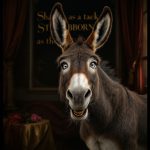Clipping Gold Coins: How Bankers Robbed the Savers
Dec 2, 2024
The practice of coin clipping unveils a disturbing facet of human nature, deeply rooted in mass psychology and our collective inclination towards deception for personal gain. Throughout history, this behaviour has manifested in various forms, with individuals prioritizing self-interest over societal well-being. As civilization advances, so does the sophistication of these deceptive practices, evolving from crude coin manipulation to complex financial schemes.
This persistent drive to exploit others seems woven into the fabric of human behaviour, perpetuating a cycle of mistrust and undermining social cohesion. Rather than fostering unity and cooperation, some are compelled by an insidious desire to elevate themselves at the expense of their peers, reflecting a darker aspect of our shared psychology.
Coin clipping is a stark metaphor for the broader challenges we face in building a just society. It underscores the need for constant vigilance and the cultivation of ethical frameworks that can counteract these baser instincts. By acknowledging these tendencies, we can strive to create systems and cultures that promote trust, empathy, and fairness, where collective prosperity is valued as highly as individual success.
Doubts Over US Dollar’s Anchoring to Gold: The Great Financial Deception
The Federal Reserve’s gradual erosion of the US dollar’s gold backing, culminating in the abandonment of the gold standard, has exposed a sinister truth: the value of the US dollar is now untethered from any tangible asset. This shift has not merely raised concerns; it has laid bare a system of financial manipulation that borders on outright fraud.
Fort Knox: A Fortress of Lies?
The shroud of secrecy surrounding Fort Knox’s gold reserves reeks of deception. Speculation runs rampant about undisclosed sales or, more alarmingly, the substitution of genuine gold with lead bricks. This lack of transparency is not mere oversight; it’s a calculated strategy to maintain a facade of stability while the foundation crumbles.
The Fed’s Ruthless Maneuver: Coin Clipping on a Grand Scale
The Federal Reserve has perfected the art of financial sleight of hand. Rather than the gradual theft of coin clipping, they’ve executed a daring heist of the entire gold backing. The most chilling aspect? The masses, in their ignorance, applaud these financial predators. This is not just coin clipping; it’s the wholesale robbery of a nation’s wealth.
The Masses’ Stunned Silence: A Rude Awakening Awaits
The average person’s understanding of gold’s significance is woefully inadequate. This ignorance plays directly into the hands of those orchestrating this financial charade. The battle for economic truth will be long and arduous, with the public’s awakening painfully slow.
The Fed: A Cabal of Brilliant, Evil Minds
Make no mistake: the Federal Reserve is not a bumbling bureaucracy. It’s a collection of ruthless, brilliant individuals who have studied and refined the art of national defrauding. They’ve learned from history’s paper currency failures and have now perfected the technique of robbing an entire nation while keeping it docile.
The True Victors: Unbiased Investors in a Zero-Sum Game
Only the cold, calculating, and unbiased investors will emerge victorious in this financial battlefield. Forget notions of collective resistance; the market is a zero-sum game where for every dollar won, another must be lost. The landscape is littered with the financial corpses of those who believed in unity against market forces.
The path to financial survival in this era of monetary manipulation demands unwavering vigilance and an unbiased approach. The Fed’s actions have created an economic ecosystem where trust is a liability and scepticism is a virtue. Only by recognizing the true nature of this grand deception can one hope to navigate the treacherous waters of modern finance.
Victory has a hundred fathers, but defeat is an orphan.
Galeazzo Ciano
Coining Clippage: Unraveling the Historical Legacy of Currency Debasement
by Alan Lunt
Clipping coinage, or debasing currency, is the modern age’s dark art. Throughout history, each attempt has failed, yet perpetrators remain oblivious. Before milling edges on gold coins, people shaved them, reducing gold content and desirability. Clipped coins were recognized as bad money and discounted. In Germany, adding lead to gold ostensibly increased the money supply but led to hyperinflation.
The Age of the Central Banker has one task: expanding the monetary base, encouraging currency debasement and causing inflation. Governments exploit this and spend added cash on “much-needed social programs.”
Eroding Savings, Nurturing Debt: Inflation’s Stealth Tax
Finance ministers knowingly steal constituents’ savings through inflation, an insidious tax that gnaws at a sound economy’s core. It creates an “incentive trap,” pushing people to spend now and borrow, fearing future price increases. This “pushing to purchase” has birthed a credit society where a credit record is paramount, even for those with millions who’ve never borrowed.
As the Kondratiev Winter approaches, debt will become a dirty word. Rising interest rates will cause defaults, and money lenders will fail. Initial indicators will be misread, but bad lending policies will surface. For example, West Pac Banking Corporation’s “How Landlords Get Wealthy” campaign ignored the possibility of falling prices and rising interest rates, dangerously driving people to leverage themselves.
Unshackling Value from Debt: The Cry for Intrinsic Worth
We need re-education on the true meaning of inflation. Rising prices are a result, not the cause. The cause is currency clipping – printing money. Look no further than your elected leaders. According to David Bond, fiat currencies historically last about 30 years from inception to collapse.
As Ludwig von Mises warned: “There are no means of avoiding the final collapse of a boom brought about by credit expansion. The alternative is whether the crisis should come sooner due to voluntary abandonment of further credit expansion or later as a final and total catastrophe of the currency system involved.”
The time to worry has passed; the time to plan is NOW.
© 2004 Alan Lunt
Guest Contributor at the Tactical Investor
Email
Unveiling Coin Clippage: Unraveling the Tale of The Holey Dollar
by John Tyler
No, folks, I did mean “Holey” rather than “Holy”, although many give the dollar God-like status.
The dollar I refer to is a more historical example of slippage. The new governor of the Colony of New South Wales, Lachlan Macquarie, in the year 1809, inherited a problematic money problem (has there ever been a simple money problem except not having enough?). There was just not enough money around. As soon as a silver dollar surfaced, it was traded for survival essentials in a new land and exported away by the trader for a vast profit. As a result, there was no coinage in the colony, and the troops had to be paid in rum!
Like today, the colony of New South Wales, the USA, needed imports to survive. Unlike the USA, however, the defiling quality of the monetary printing press was yet to be discovered, so Macquarie hatched a cunning plan.
Forging Value: The Tale of the Holey Dollar and Dump Coins
Macquarie imported 40,00 silver Spanish Dollars and had a convicted forger punch out the centre of the dollar to create a lower denomination coin, the “Dump”. This was over-stamped with the colonial crown, and the internal rim of the now “Holey Dollar” had “New South Wales “ stamped.
So we see a forger make 1 + 1= 3 while devaluing the currency to anyone who had previously been exporting the silver currency for profit. The guarantee of government also became the alchemical philosopher’s stone, creating value from more common elements. The USA made These friends when the dollar/gold link was severed.
The great irony is that a Holey Dollar is now worth $100,000 to collectors and a dump $40,000.Who knows what gold will be worth after it has been “clipped” from the dollar?
An example of a “Holey Dollar”.
Only 350 survived as they were recalled to the smelter’s pot.
© 2004 John Tyler
Paper money is just a hobby!!
By Art Soukup
What a strange-sounding phrase the above is.
What an odd notion that paper money is just a hobby.
At any rate, the phrase is essential for your economic future, so take the time to learn.
Still, I wonder if the title phrase is true. Let’s see if we can find out by first getting the definitions of words and terms. After that, we will analyse what we have found. We will start with the intention of the word “hobby.”
At this location: http://www.brainydictionary.com/words/ho/hobby173785.html, you will find this definition: Hobby.
(n.) A small, strong-winged European falcon (Falco subbuteo), formerly trained for hawking.
(n.) Alt. of Hobbyhorse A strong winged European falcon…perhaps the Eurodollar. It seems to be somehow related to a hobbyhorse, so at this location:
http://www.brainydictionary.com/words/ho/hobbyhorse173786.html you will find this definition: Hobbyhorse
(n.) A robust and active horse of a middle size, said to have been originally from Ireland, an ambling nag.
(n.) A stick, often with the head or figure of a horse, on which boys make believe to ride.
(n.) A subject or plan upon which one is constantly setting off; a favourite and ever-recurring theme of discourse, thought, or effort; that which occupies one’s attention unduly, or to the weariness of others; a ruling passion.
Delving into Hobbyhorses: A Recurring Focus on Different Paper Money Types
Hmm, A ruling passion that one focuses undue attention upon. Hmm, again, A favourite and ever-recurring theme of discourse. The editorials at various websites are always about the different kinds of paper money and their relation to precious metals; therefore, all the editorials are different kinds of hobbyhorses.
Makes sense.
We now need the definition of “paper money”, so at this location: http://www.hyperdictionary.com/dictionary/paper+money
you will find this definition: PAPER MONEY Pronunciation: ‘peypur ‘munee
Definition: [n] currency issued by a government or central bank consisting of printed paper that can circulate as a substitute for specie.
Synonyms: folding money, paper currency.
See Also: Bank bill, bank note, banker’s bill, banknote, bill, currency, Federal Reserve note, fiat money, fractional currency, government note, greenback, note.
Hmmm, paper money is a “substitute for specie”.
And specie defined: http://www.hyperdictionary.com/dictionary/specie is WordNet Dictionary
Definition: [n] coins collectively
Synonyms: coinage, metal money, mintage
See Also: coin, currency
Webster’s 1913 Dictionary
Definition: \Spe”ci*e\, abl. of L. species sort, kind. Used in the phrase in specie, that is, in sort, in kind, in (its own) form. [The king] expects a return in specie from them” [i.e., kindness for kindness]. –Dryden. {In specie} (Law), in precise or definite form; specifically; according to the exact terms; of the very thing.
\Spe”cie\, n. [Formed as a singular from species, in a sense 5.] Coin; hard money.
So coin hard money is specie, and paper money is printed paper that can circulate as a substitute for specie. We now have the words and phrases defined for the necessary insight, but where is the PROOF!!
For your reading misery, the following link points to all 50 titles of the us code. http://www4.law.cornell.edu/uscode/
I said misery because it took me about two months to read the shortest title, Title 13 Census. I had to read many other labels (a few years) until I found the proof that “paper money is just a hobby”.
Here are the links, for your reading pleasure. Read them in sequence and look for the phrase “paper money.”
http://www4.law.cornell.edu/uscode/15/ <– top link to commerce and trade.
Just a quick look. No need to read.
http://www4.law.cornell.edu/uscode/15/ch48.html <– Hobby Protection.
http://www4.law.cornell.edu/uscode/15/2101.html <– Marking requirements.
http://www4.law.cornell.edu/uscode/15/2102.html <– Private Enforcement.
All the exciting stuff in the US code seems to be stuffed under definitions or misc.
So at this location: http://www4.law.cornell.edu/uscode/15/2106.html <– Definitions. You find in Section THREE: (3)
The term ”original numismatic item” means anything that has been part of a coinage or issue used in exchange or to commemorate a person or event. Such items include coins, tokens, paper money, and commemorative medals. Hmmm, “used to celebrate a person, “… so that’s why there is a picture of a person on the paper: George Washington, Alex Hamilton, the Queen of England, and so on.
So you now have PROOF that “PAPER MONEY is just a hobby” ” requiring some protection because it is an ORIGINAL nominal item that is (Falco subbuteo), formerly trained for hawking. Gee, by now, you should be getting a warm fuzzy feeling that your entire wealth is based upon someone else’s HOBBY, which occupies one’s attention. So much for the concept of “Valuations”.
One nice thing about gold and silver is that no hobbyhorse can print the stuff.
© 2004 Art Soukup
“In the land of the blind, the one-eyed man is king.”
Email
Mental Odyssey: Embark on a Quest for Knowledge













